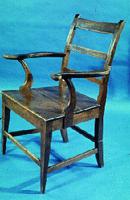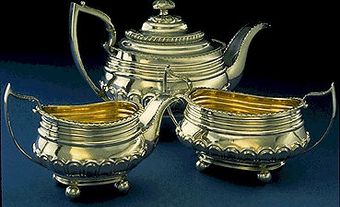Furniture, Country
In studies of antiques or material history, "country" (ie, traditional, provincial or folk) styles are contrasted with stylized or formal ones. What one individual calls country and admires perhaps for its decoration or painted finish, another may reject as crude and primitive. Although some may expect formal furniture to be constructed of finer hardwoods (eg, walnut, cherry, mahogany) and country furniture of softwood (eg, pine), an understanding of the difference between country and formal furniture goes beyond methods and mediums of construction, forcing consideration of other factors, including where and when the furniture was produced.
Country furniture is probably best understood as material produced after or similar to the mainstream of influences or period styles (eg, Chippendale, Hepplewhite, Sheraton), using local woods and influenced by the limitations of the cabinetmaker's tool chest, imagination and level of workmanship. Country furniture includes all types found in formal furniture (eg, tables, chairs, cupboards, chests) as well as additional forms.
Maritime Provinces
Settlement in the Maritimes (comprising NS, NB and PEI) was essentially a rural experience. Although port cities such as Halifax and Saint John were important as political, social and economic centres, most people lived in small farming and fishing communities. Because of distances, lack of adequate roads and unreliable methods of transportation and communication, contact between the regions was limited and rural areas were isolated from urban centres and mainstreams of fashion and taste.
After the expulsion of the Acadians (1755-63), the first influx of immigrants began with the arrival of the Planters from New England, followed by the Loyalists in 1783-84 and a substantial Scottish migration in the early 19th century. Although many of these settlers brought or imported their domestic furnishings, the migration included cabinetmakers, carpenters and joiners whose arrival and settlement quickly led to the establishment and production of indigenous Maritime-Canadian furniture, based on English and American styles familiar to the craftsman.
Because cabinetmaking was essentially a conservative craft based on an established Apprenticeship system, and because furniture styles have a tendency to persist over long periods of time, the country furniture produced in the Maritime provinces from about 1770 to 1850 reflected the continuation of earlier styles such as Chippendale. Only in cities, which were open to the influx of new fashions, would one expect furniture styles to attempt to keep pace with new developments and trends in taste.
The rural character of Maritime society also influenced the choice of construction materials. Except in urban centres, particularly port cities, where exotic woods (eg, mahogany) were available to local craftsmen, most furniture was constructed of immediately available woods (eg, pine, birch, maple). Figured hardwoods (eg, birch, maple) were commonly used in both formal and country furniture because of their decorative grain. Country furniture (particularly that produced in pine) was often painted to represent more formal furnishings in exotic wood. In some cases, these painted finishes, which are often very vibrant and colourful, are the most important distinguishing feature of country furniture.
French (Acadian), English, Irish, Scottish and German influences are evident in the country furniture styles of the Maritimes. All ethnic groups used similar types of domestic furnishings, including blanket boxes, chests of drawers, tables of various sizes with and without drawers, chairs with and without arms, and corner and flat-to-the-wall cupboards. Not all groups, however, are represented in all 3 provinces, and some groups lavished more attention and detail on certain types of furniture than on others.
Newfoundland
No furniture is known from Newfoundland which can be dated earlier than 1810-20, when restrictions on land granting were lifted and local development encouraged. The first British-trained cabinetmakers, Mark Green and George Hancock, arrived in St John's in 1815 to serve its growing population. Samuel Creed came from Halifax about 1833 and his surviving work suggests a conservative approach to current furniture styles. The fact that W. Gammon produced Windsor chairs in both Halifax and St John's, and that similar comb-back Windsors are found both in NS and Newfoundland, suggests an early, strong craft connection in the Atlantic region.
Although some cabinetmakers worked in major outports such as Harbour Grace, most were in St John's, the economic and political capital. That city had 6 cabinetmakers in the 1840s, 10 in the 1870s. Matthew Pope's furniture factory, opened in 1859, was one of a number that produced household and institutional furniture. What is known of the work of these individuals and factories suggests that their work was not imaginative; they were content to copy pattern-book styles to the limit of their abilities and equipment. There were exceptions; for example, H.W. Winter's workshop at Clarke's Beach, Conception Bay.
Real imagination can be found in outport furniture, whether homemade or made by a local carpenter. In such pieces as washstands and benches, the whole repertoire of decorative treatments - eg, chip carving, applied motifs, spindles, chamfers, moldings and arches - was exploited in inventive combinations augmented by strong colours in the paintwork. Where a particular skill was required, eg, with chairs requiring joinery, conservatism crept in.
Old styles survived and new ones were adapted to the limitations of the craftsman and his tools. A form of chair generally considered 17th century, the Carver chair, was made until the end of the 19th century. Sheraton chairs are not uncommon (Chippendale are rare) but never have the turned leg (which requires a lathe) associated with the style; rather, they have the square-tapered Hepplewhite leg, which was easier to make. Similarly, because of the difficulty of producing them, no chairs with the Hepplewhite shield-back or Victorian balloon-back are found.
This interaction of professionalism and conservatism can also be found in kitchen dressers of the 1810-20 period. These pieces were probably the work of housewrights, because they were generally part of the whole architectural treatment of the kitchen. Because the housewrights were not constructing for themselves, they could not indulge their imaginations and had to construct something which spoke of the owner's standing in the community, a situation which inspired conservatism.
At the end of the 19th century, the appearance of factory-made furniture, the availability of mail-order catalogues (the ordinary man's pattern book) and the more widespread use of woodworking equipment had their first effect on outport furniture. Chairs and settees in what must be called "Catalogue Style," with thin frames and applied decoration, replaced an earlier factory form, Eastlake, with machine-gouged decoration.
Furniture imitating these forms is generally found outside St John's, where it was difficult to get "bought" furniture. It has an element of expediency, making use as it did of salvaged wood from packing cases or houses as well as of whole elements (eg, legs) from discarded furniture. Such curious combinations reflect an economy that discouraged waste.
Because of Newfoundland's location on the periphery of North America and its marginal economy, the island's furniture, like many of its other Crafts, never entered the mainstream of the other Atlantic nations. As a consequence, Newfoundland retained earlier forms and construction techniques but applied to those forms a range of decorative treatments that speak of a strong and vigorous visual imagination.
SHANE O'DEA
Ontario
The phrase "country furniture" aptly describes most surviving antique Ontario furniture held privately and in museum collections. Settlement began after the American Revolution and intensified during the 19th century. In those first years, the pressures of pioneering life ensured that most families had little time or money for high-style furniture, let alone access to it.
Ontario country furniture was fashioned of native woods (eg, walnut, maple, cherry, birch, oak, basswood, pine), by hand, usually with some skill. It can be divided into 3 categories: copies of high-style furniture of British and American derivation; furniture with form and decoration of French, German and other European ethnic origin; and sturdy utilitarian furniture that was used almost universally in town and country and in the less important rooms of city homes.
All of the Georgian, Empire and Victorian styles were reproduced, alone or in combination, with varying degrees of success. Ontario cherry and figured maple provided excellent substitutes for imported mahogany and satinwood. Stain and paint were employed to simulate costly woods, veneers, inlay and carving, when cost or lack of skill or tools forbade such embellishments. Especially during the early years, cabinetmakers were more likely to use hardware (ie, hinges, handles, etc) that was readily available rather than what matched the style of the furniture. Decorative motifs such as the German 6-sided star and French diamond-shaped panels sometimes were used on country furniture that was British or American in form and style.
Relatively few tools were needed to construct utilitarian furniture so it could be undertaken by most carpenters as well as joiners and cabinetmakers. Dual-purpose, space-saving forms included a chair with a back that could be lowered to form a table top, and a bench with a seat that unfolded to a full bed.
Country chairs fall into 3 groups: slat-backs, Windsors and Fancy chairs. Slat-back chairs had 4 turned legs, the rear ones extended and joined by several slats at the top to form a ladder back. A variation, the banister-back, had 2 slats, pierced by several vertical spindles. Woven ash splints or elm bark formed the seats.
The Windsor, a chair of English derivation, was constructed like a stool with a back attached to the seat. Such chairs were named according to either the style or the shape of the back, eg, Sheraton, loop- or bow-back, arrow-back, low-back or Captain's, comb-back, spindle-back, short spindle-back or chicken coop, and gunstock. Slat-backs and Windsors were made as side chairs, armchairs and rockers; most were painted.
Fancy chairs were side chairs with back, seat and leg patterns derived, at least in part, from Georgian and Victorian styles. Decorative, figured wood often was used; the seats were made of cane or rush. Many Windsors and Fancy chairs also were produced in early Ontario furniture factories.
The high, heavy, 4-post, rope-spring bedstead and accompanying trundle bed were succeeded by a lower, lighter spool-turned bed with slats. Hired-man cots, with spool-turned ends, became country settees when spooled or solid backs were added. Tables and stands of all sizes and for all purposes had tops that tilted, lifted, pivoted or were detachable, and leaves that could be dropped, drawn out or detached.
Country schoolmaster desks with slanted lift tops might be attached to or detachable from a long- or short-legged frame below and a postmaster cupboard with pigeonholes above. Drop-front desks were composed of a cupboard front that dropped to form a writing surface, supported by a table or a lower cupboard.
Country cupboards of one or 2 pieces, with glazed, solid, or no doors, some having a pie shelf sandwiched between the upper and lower parts, were built into corners or walls or were free-standing. They were made in many sizes and shapes for storage of food or dishes and as dry sinks. Linen presses and wardrobes were constructed with fixed parts or, for ease of relocation, detachable ones. Most cupboards were painted or stained dark. Lift-top box chests, the earliest and best made of 6 dovetailed boards, were numerous and even incorporated into the top part of early chests of drawers.
ELIZABETH INGOLFSRUD
Manitoba - Red River
With the arrival of the Selkirk settlers in 1812 and the subsequent construction of permanent establishments by the Hudson`s Bay Company and North West Company, domestic residences and a tradition of country furniture were introduced in the Red River valley. From the outset, the geographic isolation of the Red River Colony and the logistic difficulties inherent in transport worked against the importation of furniture. Furniture sent out by the London-based HBC had to be transported by the annual ship to York Factory, transferred to the York Boat brigades and carried the 1300 km inland to Red River.
Aside from company officers, who imported fine furniture, employees were limited to the quantity of household goods they could transport in small wooden trunks or cassettes. The early settlers in Red River confronted these transportation difficulties by producing their own furniture on a modest scale. Settlers and company personnel who had the tools fashioned tables, chairs (eg, the Red River chair, a sturdy pine chair with a plank seat), storage chests and beds that put utility and structure ahead of ornament.
Consequently, furnishings in even the centrally located fur-trade posts at Red River were characterized by simplicity, even austerity. Because the Red River community was primarily French, Scottish and English in cultural antecedents, no single, distinctive furniture tradition emerged.
Examples of surviving country furniture (chairs, chests, cradles, sofas, sideboards) are housed in private collections or museums and historic parks such as St-Boniface Museum or Lower Fort Garry. The principal woods used were oak, pine and ash, which were readily available in the area. After frames were carefully cut and fitted, joints were firmly fastened by wooden dowels, varying in diameter from one-quarter inch (about 0.5 cm) in the HBC "board room" chairs to one-half inch (about 1 cm) in beds and sofas.
Generally, the furniture was left in its natural state until the 1870s, when many pieces were stained, waxed and ornamented with carvings of flowers or other designs. By the 1860s improvements in transportation through the St Paul route and the arrival of professional cabinetmakers spelled the decline of country-made furniture in the Red River valley.
GREGORY THOMAS
Authors contributing to this article:
Prince Edward Island
The flat-to-the-wall kitchen cupboard, usually with an open top, seems to have been the focal point of furnishings of Scottish and Irish homes during the 19th century. Although most of these cupboards were made by unknown craftsmen, PEI is rich in examples of furniture signed or in some way identified by its makers. Such cabinet and chair makers include Benjamin Chappell, a wheelwright from London who arrived in 1774, and Samuel Bagnall, a Loyalist who arrived from Philadelphia in 1787. Both are well known for their chairs, examples of which exist in both public and private collections.
New Brunswick
is also rich in furniture by known makers, particularly in Saint John, which was the most important centre of cabinetmaking. Known cabinetmakers working before 1800 include Robert Chillas, who arrived from New York in 1783; Daniel Fowler, who settled in 1785; and Nathan Oaks and Robert Blackwood, who took out Freeman papers (received upon payment of a registration fee and the swearing of an oath of allegiance in order to operate a business in Saint John) in 1795 and 1796.
Nova Scotia
Like Saint John, Halifax was an important centre of cabinetmaking. NS saw the largest immigration of "Foreign Protestants" in the Maritimes. Lunenberg was settled by German-speaking immigrants in 1753. Although the initial migration numbered less than 2000, the Germans gave Lunenburg county a distinctive tradition and culture which still survives. One of the early Lunenburg town furniture makers listed in 1794 as a turner and wheelwright was Casper Jung, who later anglicized his name to Young.
In Halifax many signed examples of Windsor chairs are known by such makers as James Cole (about 1817), who came to Halifax from the US; George Gammon (about 1838), who worked in Cole Harbour, Halifax County; and Joy Humeston (about 1805), who made Windsor-style bamboo chairs and settees in Halifax. The Sibley family of Colchester County made other types of furniture but their chair, with its distinctive, shaped back slats and mushroom finials, is best known. Beginning with Joseph Sibley (born 1790), who was known locally as the "chair maker," the Sibleys continued in operation until 1900.
Of the Maritime provinces, NB and NS saw the largest influx of French-Acadian immigrants, beginning with the establishment of Port-Royal in 1605. Expulsion of these Acadians was accompanied by the confiscation or destruction of such of their belongings as they could not carry with them. Therefore, much of the furniture identified today as "Acadian" actually dates from the postexpulsion period when, beginning in 1764, the French-Acadians returned to the region.
By the middle of the 19th century, the craft tradition of furniture manufacture was rapidly being replaced by mechanization and factory production. Although in certain rural areas, such as parts of PEI, earlier furniture styles persisted well into the late 19th century, the cabinetmaking-apprenticeship tradition slowly disappeared as the Maritimes moved into the industrial age.
RICHARD HENNING FIELD

 Share on Facebook
Share on Facebook Share on X
Share on X Share by Email
Share by Email Share on Google Classroom
Share on Google Classroom




